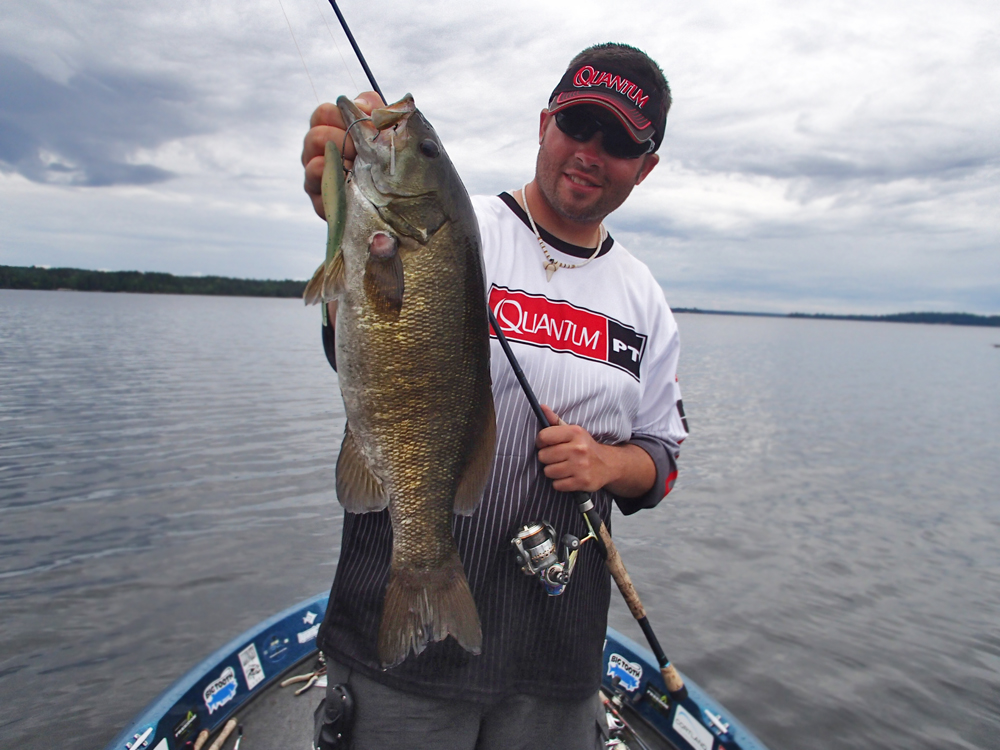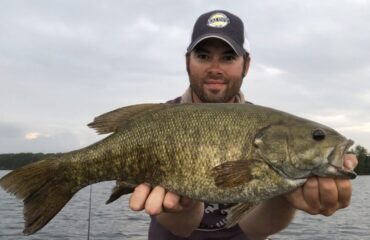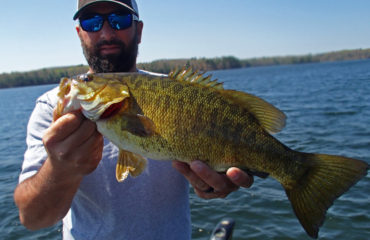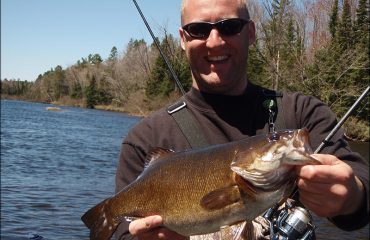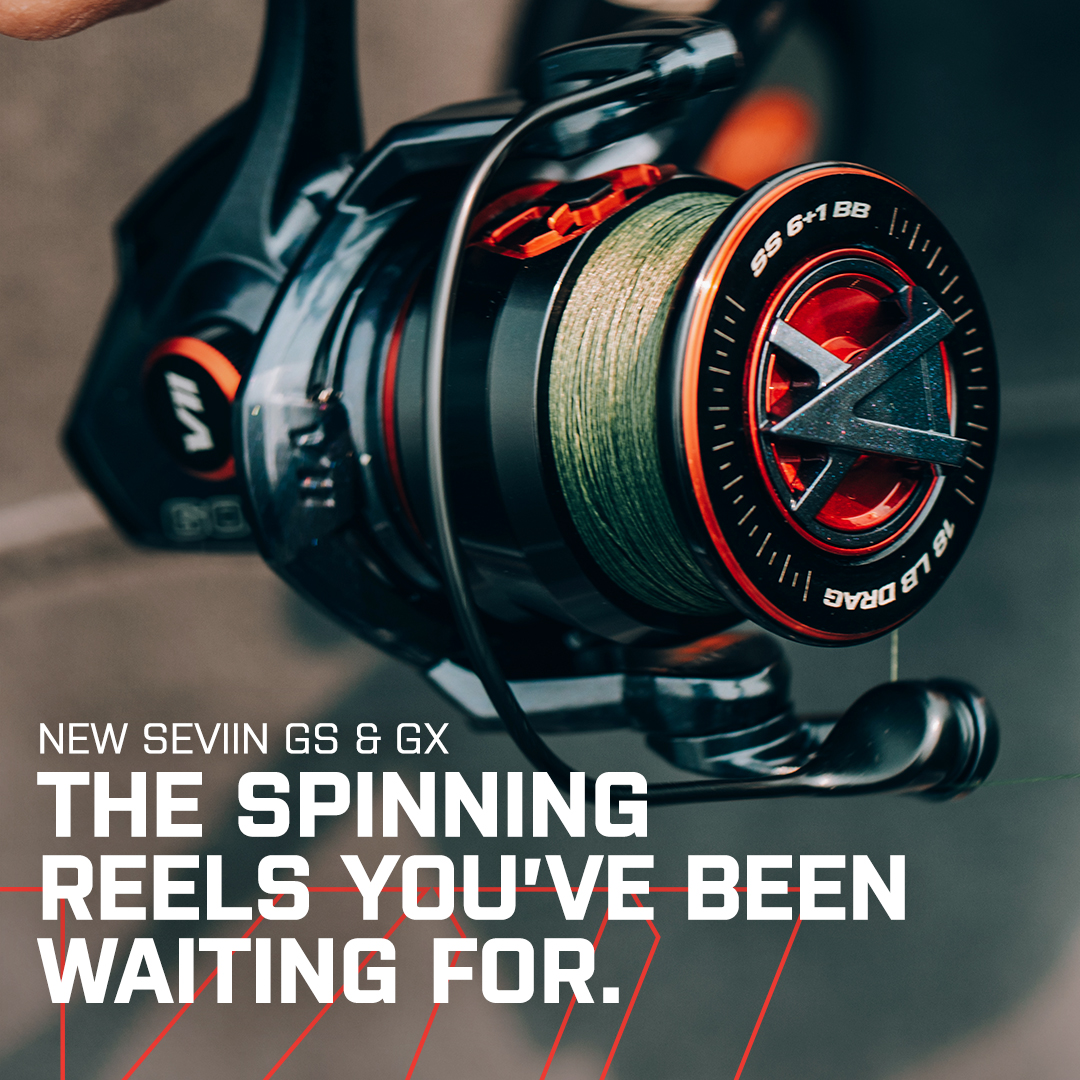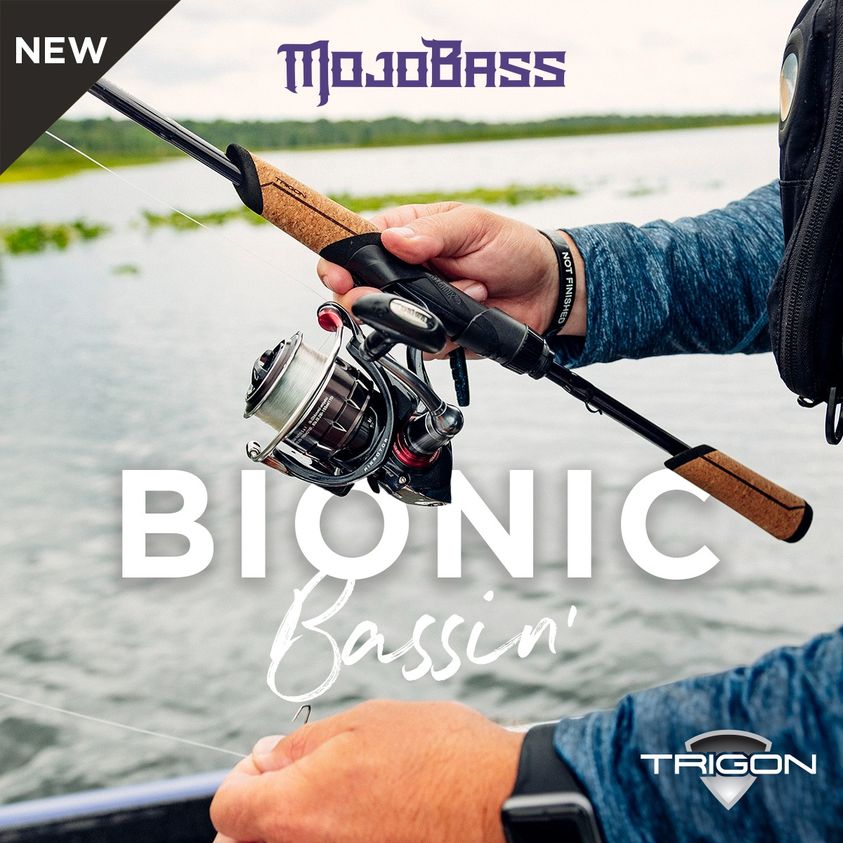Onboard and Offshore
By Andrew Ragas
During summer’s dog days, some anglers give up on smallmouth bass. Others, meanwhile, are too stubborn to change their fishing ways.
“I’m a shallow water guy,” boasted the angler launching his $80k rig before me one morning last August. “If I can’t catch them beating the bank, I’m probably not going to catch them,” he added. “I just can’t make myself to fish offshore,” he concluded.
One of the biggest mistakes bass anglers make is their reliance and dependence on fishing shorelines, docks, and near-shore habitats. Usually in summer, this breaks a trip. Don’t be a bank beater like that guy. Don’t settle for nurseries of little fish, and the most pressured fish.
Old habits are hard to break. Most angling pressure bass receive from lake fishermen is near shorelines. Look over the shoulder, and you will learn the best smallmouth fishing in the entire lake is out towards that direction where you’ll rarely ever see other bass boats fishing.
As the shallows and near-shore areas of lakes get fished the hardest, the trophy summer smallmouth I focus on catching the most are the least pressured specimens of the lake. By now in the season, their placement and lake locations are offshore. I usually have these fish all to myself on most lakes.
Smallmouth bass are primarily offshore and deep structure-oriented fish year-round, only to be found shallow, up on some shorelines, in spring and during specific summer and fall scenarios when food availability and water temperature is ideal. Smallmouth spend majority of their lives in deep water, away from shorelines. While smaller members of the population are least educated and tend to favor living in the shallows until they reach a certain age and homing preference, the largest members of most smallmouth populations will usually live offshore, and around deep structure, where they will be least pressured and exploited.
With these fishing advantages come challenges. Disconnected for shorelines and shallow structure, big bass become more difficult to pinpoint with regularity. They are elusive creatures now.
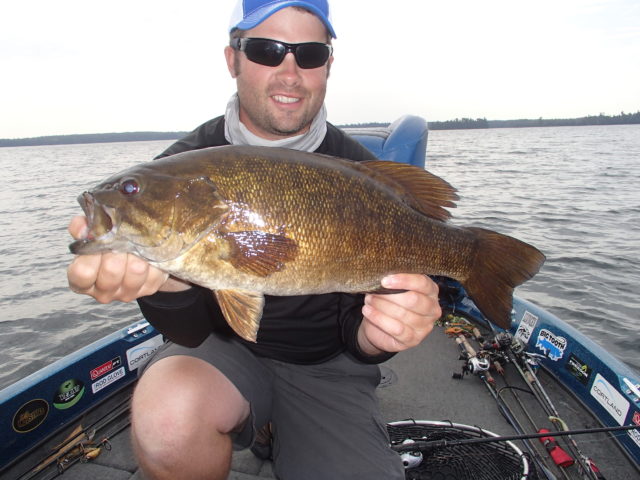
Most angling pressure bass receive from lake fishermen is near shorelines. Look over the shoulder, and you will learn the best smallmouth fishing in the entire lake is out towards that direction where you’ll rarely ever see other bass boats fishing. The author, with a 21 incher that was caught onboard and offshore, with no shorelines in sight.
Dog Day Bronze
July through August is the longest and hottest months in the north. Summer peak sets in. Lake biomass hits a high as well, resulting in smallmouth scattering into open water to chase suspended schools of cisco and smelt.
By this time of season, majority of all adult smallmouth bass are living offshore, around main lake areas and congregating near deep structure of the main basin. The near-shore areas they were relating to in May and June have now become nurseries, where fish are aggressive but consistently small. For the remainder of the season, until they spawn again in spring, most big smallmouth will be offshore. The mid-season movement has led fish to school deep for feeding and staging for overwintering.
Contrary to popular belief, big smallmouth are cool water species, preferring cool, well-oxygenated water temperature ranges of 65 to 72 degrees that are centered on thermocline areas and the lake’s specific depths with structure for them to hold near.
Mid-summer smallmouth have peculiar daytime feeding habits. Smallmouth schools work together to capture the most food while burning the least amount of energy. As a result, multiple feeding windows take place throughout the day. Anglers themselves must work harder to capitalize on these events, as they can happen at any time.
Dog days of summer fishing is the most difficult, but rewarding time of the fishing year. Odds for big fish are low, but possible each day.
The primary motivation for smallmouth in mid summer is food. The key is identifying the most prolific food sources that a lake has, and then determining what areas of the lake could be concentrating those forms of prey. On my waters, it’s often native and rusty crayfish, cisco, and yellow perch. On some other waters, it’s rainbow smelt.
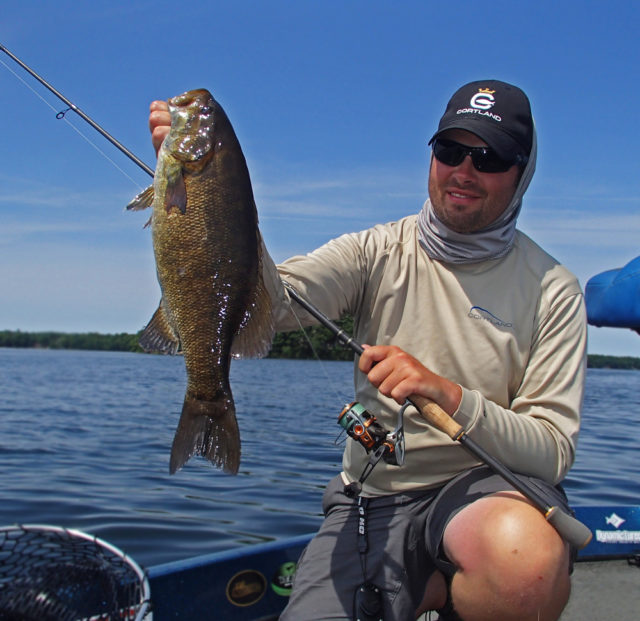
Dog day fishing strategies aren’t revolutionary, but it’s all about presenting baits naturally and with methodology to represent the living creatures smallmouth feed on.
Don’t Beat the Bank
Savvy bass anglers who’ve learned to fish offshore know how to position themselves where food is.
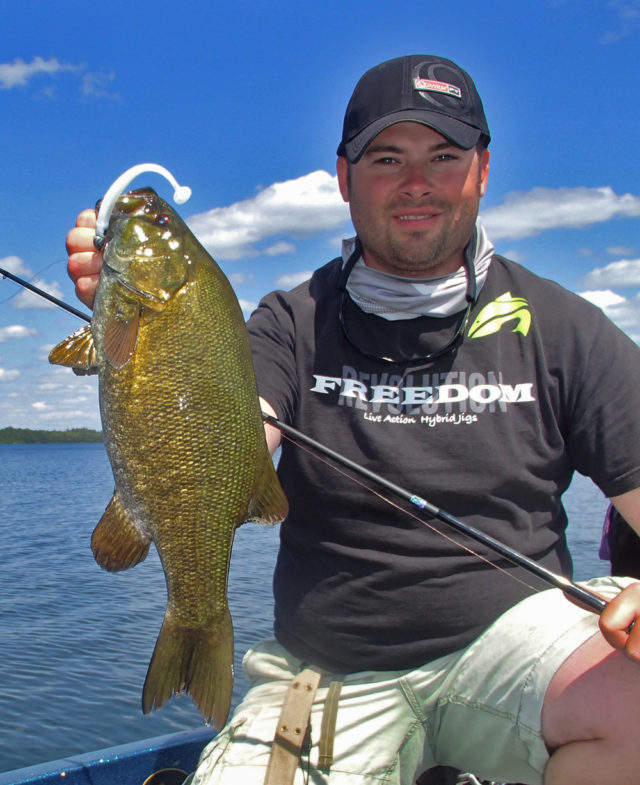
Casting presentations are effective when cisco schools are prevalent. Working jig and paddletail swimmers throughout the water column is easy and engaging fishing that plays well on our clear water smallmouth fisheries of Wisconsin.
On many natural lakes throughout Northern Wisconsin, I have learned how to identify adult smallmouth locations. July and August is often the best time of year to catch these big bass. While the boat’s catch rate and numbers goes way down, the probability for big fish increases, with 4 to 6 lb. fish being possible almost daily.
Big smallmouth are difficult to catch during daytime, but they move into predictable areas. On most northwoods lakes, trophy smallmouth move to structures near the deepest basins of the lake. On these inland lakes, many of these areas are isolated mid-lake rock humps and a series of reefs that are surrounded by deep water. Some are also big shoreline points that extend into the main basin. On some other lakes that are lacking in topography and deep rock structure, it could be isolated forests of sand grass, and the deepest coontail and cabbage beds available.
The biggest smallmouth we catch are often associated with rock piles and deep boulders. Vertical jigging and drop-shotting them produces the most bites. Crayfish are most prevalent in these areas. Humps and rock piles that peak at 15 to 25 ft. that can be successfully dragged with heavier tubes and football jigs are my go-to areas in late summer.
This time of year, deep on most lakes is considered 15 to 25 ft. On others, it could be 30 to 50 ft. depending on whether a thermocline has established for summer. Other than evenings, nights, and early mornings, we rarely spend time fishing shallow water during midday and when water temperatures are pushing 80 degrees.
Not finding smallmouth in their deep summer spots? Go check on their fall locations. By the time summer peak sets in, the fall pre-wintering movements have just initiated.
Summer Patterns
Consistently catching big summer smallmouth in open water under the sun’s heat and around heavy recreational boat traffic is a difficult task. However, mid-summer smallmouth patterns are predictable once locations and forage preferences have been identified.
Structure Presentations – Drop shotting catches the most numbers, but is rarely a big fish producer for my boat or anywhere in the north. Our deep water fish aren’t pressured and you don’t need to target isolated areas and shake a plastic to get bites.
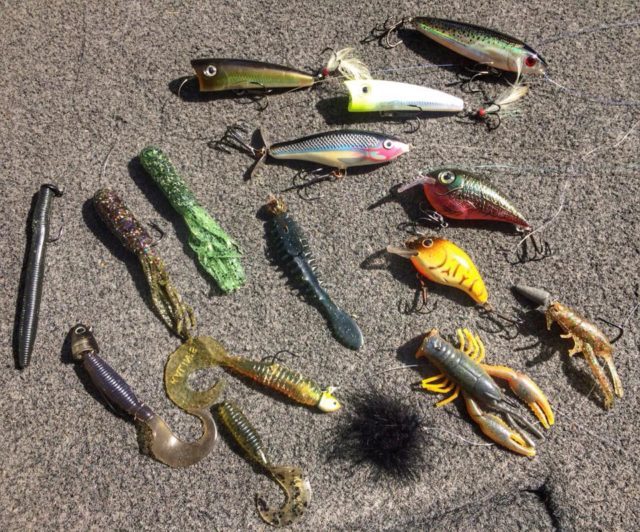 For most who enter my boat, a heavier ¼ oz. Strike King Coffee Tube in crazy craw rigged with Freedom Tackle Corp’s Zodiac Swinging Heads, and a ¼ oz. black Ned Rig works better than anything else for the biggest bites. Both are fairly snag resistant when fished with braided lines with a 10 lb. fluorocarbon leader. Cast both to about 50 ft, then let sink to the bottom. Most bites will happen after the first pulls and drags, and intermittent dead sticking.
For most who enter my boat, a heavier ¼ oz. Strike King Coffee Tube in crazy craw rigged with Freedom Tackle Corp’s Zodiac Swinging Heads, and a ¼ oz. black Ned Rig works better than anything else for the biggest bites. Both are fairly snag resistant when fished with braided lines with a 10 lb. fluorocarbon leader. Cast both to about 50 ft, then let sink to the bottom. Most bites will happen after the first pulls and drags, and intermittent dead sticking.
For probing better through structure, 3/8 to ½ oz. football head jigs fished with an assortment of craw trailers, and heads rigged with 4 inch swimming grubs or paddletail swimbaits and slowly retrieved deep can generate power bites.
A number of lakes have mid-lake humps that top out shallower at 5 to 10 ft. On these shallower bars, we often fish aggressive topwater tactics first. On calm days, a Rapala X-Rap Pop retrieved slowly and with loud splashes over the tops will entice some of the biggest smallmouth that reside around that structure.
Pelagic Presentations – My experience fishing northern smallmouth waters such as Lake of the Woods and Rainy Lake has helped teach me how to catch summer smallmouth that suspend deep in open water. On these two fisheries, smallmouth schools frequently follow schools of pelagic baitfish. On Rainy Lake, the prominent species is smelt. Some northern Wisconsin lakes have been illegally introduced with rainbow smelt, and applying these Canadian tactics to my local waters has resulted in summer success nobody else has tried.
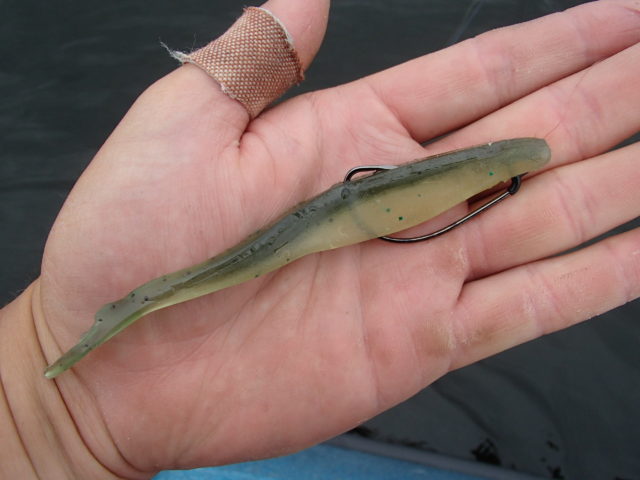
My experience fishing northern smallmouth waters such as Lake of the Woods and Rainy Lake has helped teach me how to catch summer smallmouth that suspend deep in open water. On these two fisheries, smallmouth schools frequently follow schools of pelagic baitfish. On Rainy Lake, the prominent species is smelt. Tex-pose rigging lightly weighted, translucent patterned fluke minnows and letting them glide slowly throughout the upper water column is effective.
On these smelt fisheries, Tex-pose rigging lightly weighted, translucent patterned fluke minnows and letting them glide slowly throughout the upper water column is effective. Another prominent technique is vertically jigging white and silver 4 inch soft minnows on a ¼ oz. minnow shaped head such as Northland’s Slurp! Jigs. Tied so the head is positioned horizontally, drop it below the boat, jiggle it lightly, and smallmouth rise up with curiosity to eat it. Even though smelt populations continue to decline on many northern waters, diligence with down imaging and CHIRP electronics and spot-locking the boat with my Minn Kota Terrova helps make this vertical bite happen. It will even work on cisco fisheries, and also in sand grass beds that are commonly filled with yellow perch too.
Casting presentations are effective when cisco schools are prevalent. Working jig and paddletail swimmers throughout the water column is easy and engaging fishing that plays well on our clear water smallmouth fisheries of Wisconsin.
Take a 3.8” paddletail, and rig it on a swimming style jig head. Bomb cast, count the bait down to the suggested depth of the cisco school, and let the wagging tail and wobble of the head do the work for you. A slower, steady retrieve is best, but I will mix it up with rips and pauses so that the bait slow-rolls back to the bottom and the illusion of a minnow in distress triggers a strike. Maintain the depth ciscoes and smallmouth are at.
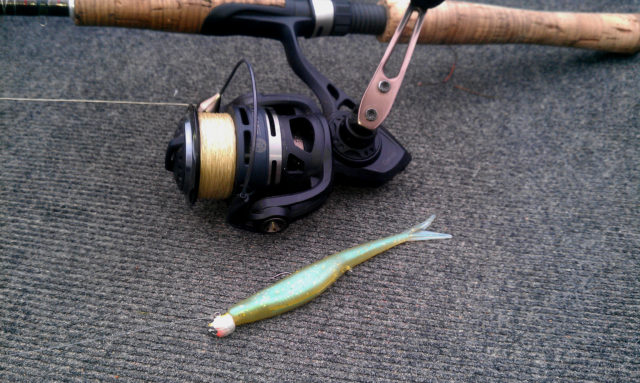
On these smelt fisheries, Tex-pose rigging lightly weighted, translucent patterned fluke minnows and letting them glide slowly throughout the upper water column is effective. Another prominent technique is vertically jigging white and silver 4 inch soft minnows on a ¼ oz. minnow shaped head such as Northland’s Slurp! Jigs.
I employ two swimmer systems. The first, and my preferred, is fished with a Freedom Tackle Corp. Hydra ½ oz. swinging head jig in white color. It promotes power, vibration, and a wide wobble from head to tail. The second is with a 3/8 oz. and ½ oz. Trokar Boxing Glove jig that serves well as a more compact option.
If smallmouth aren’t charging hard at the swimmer, tone down the presentation’s action by fishing the Trokar Boxing Glove Jig with 3.8” Strike King Rage Swimmer in Ayu, Pearl Flash, and Pro Blue Red Pearl. The exposed hook will restrict the swimbait’s motion and tail action, but will pin nearly every fish that strikes or nudges the bait.
For this open water casting strategy, I’m obviously looking for pods of cisco on side imaging, but also looking for mid depth and shallow humps and rock structure that’s immediately near deep open water and main lake basins. Big smallmouth often use the deep edges and bases of those humps as ambush points to gang up on passer-by schooling cisco.
Dog day fishing strategies aren’t revolutionary, but it’s all about presenting baits naturally and with methodology to represent the living creatures smallmouth feed on.
Onboard and Offshore
Bank beating is impractical to consistent smallmouth bass success and limits the growth and evolution of an angler. Near-shore fixated anglers fail to understand that a high percentage of an entire lake’s shoreline in summer is mostly dead, unproductive water. Look over the shoulder, as by mid summer a huge percentage of the lake’s bass is now living offshore.
Fishing onboard and offshore requires good mapping and charting skills in order to break down structure, and strict reliance with side imaging and electronics to help find smallmouth and forage.
Operating with a combination of Lowrance HDS 12 and Elite Ti units, I always keep their Navionics chips maintained and updated at the latest versions. Every year, many of the most topographically rich waters are updated with greater charting detail.
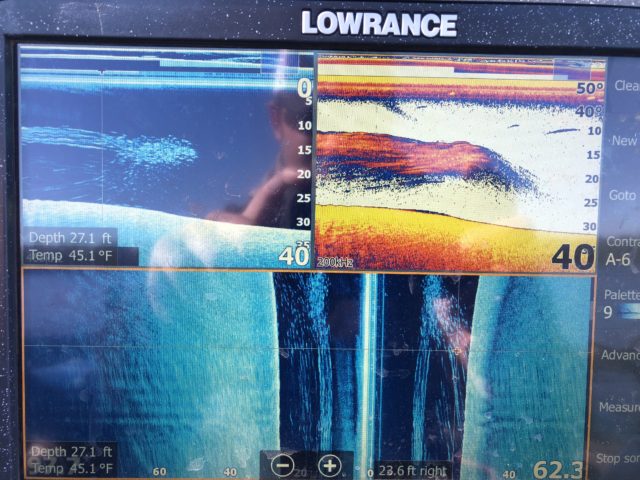
When navigating your way around the lake, idle around locations and chart those areas first until you feel more comfortable fishing them. A combination of Navionics and CHIRP on my screen’s top two panels helps find location and fish below, and side imaging on the entire lower panel helps me identify structure, bottom content, and nearby forage species. Drop some waypoints onto all targets you find. Continue scanning the rest of the spot until completed. Turn around and then start jigging and casting.
The shallows of lakes continue to be fished and mapped to death by bank beaters. Big smallmouth are wise for leaving these lake regions at the completion of their spawning season and avoiding pressure for the remainder of the year.
As our lakes near-shore habitats and locations continue to absorb the greatest number of anglers and exploitation, their much more expansive vast main lake and open water basins have gone ignored and mostly unpressured. Their trophy smallmouth fisheries are still largely untapped and undiscovered by anglers.
Most bass fishermen mistakenly believe a lake’s biodiversity and fishing productivity lessens as you fish deeper water down towards its thermocline. That belief exists in part because it’s more difficult to consistently catch fish as you cover greater ranges of depth and large expanses of surface acreage. Bass populations in these main lake and open water environments might also be of lower density too. Even though these factors add to the level of fishing difficulty, don’t let fear of offshore fishing and reliance on fishing shoreline regions dictate your bass fishing strategy. In mid summer, these regions of the lake will contain the highest number, and greatest probability of catching trophy smallmouth.
Look over your shoulder again. The best fishing for big daytime summer smallmouth happens out in the lake’s main basin where most bass boats seldom fish. Patterning offshore mid summer smallmouth and forage movements confirms this shift in summer fishing strategy. These offshore fishing efforts in summer will also set you up perfectly for what’s to come in the fall season too.
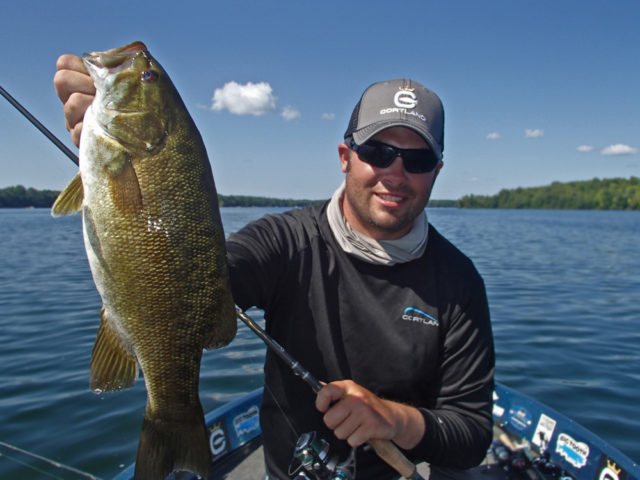
As our lakes near-shore habitats and locations continue to absorb the greatest number of anglers and exploitation, their much more expansive vast main lake and open water basins have gone ignored and mostly unpressured. Their trophy smallmouth fisheries are still largely untapped and undiscovered by anglers.
Andrew Ragas splits time between the Chicago area and Wisconsin’s Northwoods. Based in Minocqua, WI, he specializes in trophy bass fishing and offers guided trips from May thru October. While big bass is the passion, he dabbles in multi-species as well. He may be visited online at www.northwoodsbass.com


